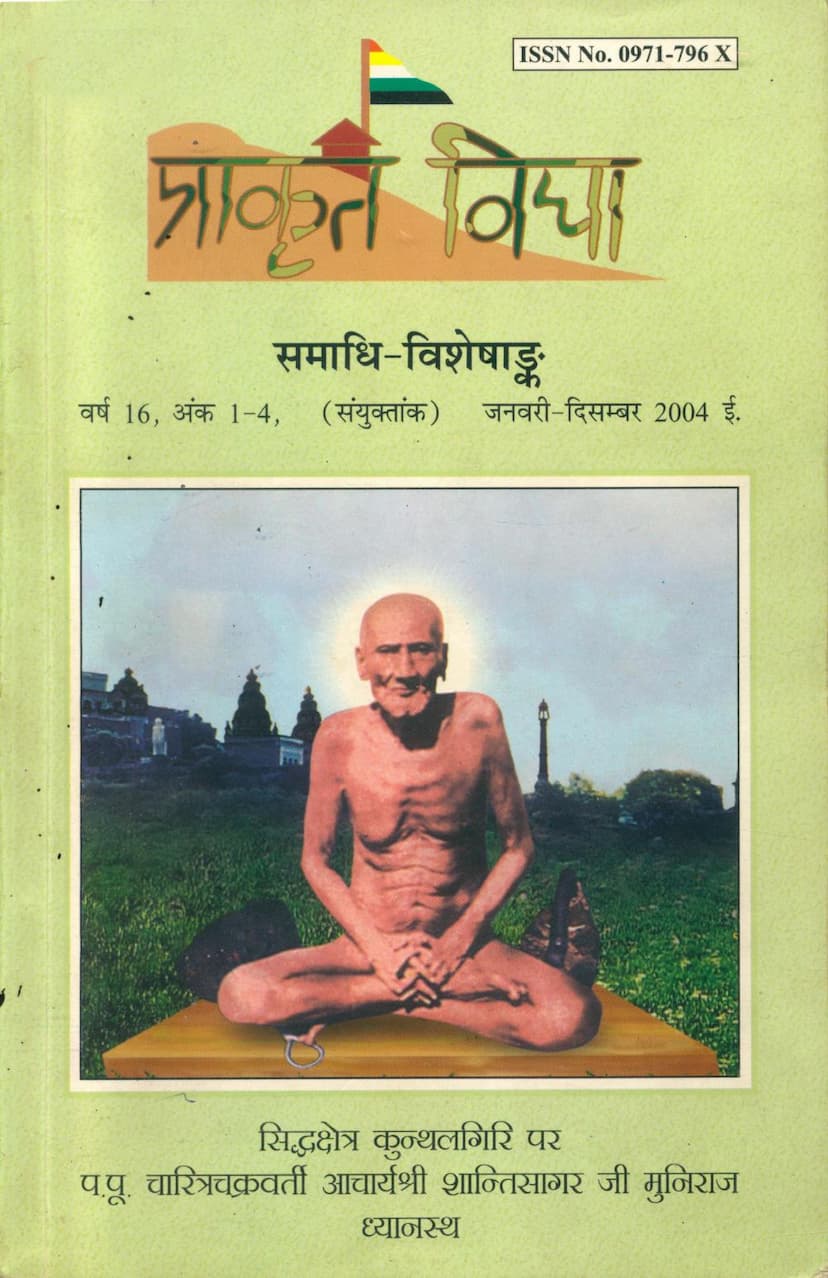Prakrit Vidya Samadhi Visheshank
Added to library: September 2, 2025

Summary
Here's a comprehensive summary of the provided Jain text, "Prakrit Vidya Samadhi Visheshank" (Volume 16, Issue 1-4, January-December 2004), published by Kundkund Bharti Trust. The text focuses heavily on the Jain concept of Sallēkhanā (समालेखना), also known as Samādhimaraṇa (समाधिमरण), which is the Jain practice of intentional, non-violent fasting to achieve a peaceful and mindful death.
Core Themes and Concepts:
- Reinterpreting Dhanteras as Dhayantaras (Pages 2-3): The issue begins by highlighting the importance of meditation, contrasting it with the materialistic focus of "Dhanteras." It asserts that the day before Diwali, when Lord Mahavira attained omniscience and liberation (Nirvana), should be observed as "Dhayanteras" (Meditation Day) due to his profound state of pure meditation. This emphasizes the Jain value of spiritual pursuit over material wealth.
- The Centrality of Sallēkhanā/Samādhimaraṇa (Pages 5-46): The majority of the articles revolve around Sallēkhanā and Samādhimaraṇa. This is presented as the pinnacle of Jain spiritual practice and a crucial element for achieving liberation (Moksha).
- Definition and Purpose: Sallēkhanā is defined as the gradual and voluntary reduction of intake (food, water, etc.) and the weakening of passions (kashayas) and the body, undertaken with a calm and equanimous mind. Its primary purpose is to purify the soul, detach from the physical body, and achieve a state of spiritual peace at the time of death. It is explicitly differentiated from suicide and considered an act of self-preservation of one's spiritual progress.
- Conditions for Sallēkhanā: It is prescribed during specific critical conditions like incurable old age, severe and untreatable diseases, unavoidable calamities (like famine or natural disasters), or when one's physical strength deteriorates to a point where spiritual practices can no longer be effectively pursued.
- Types of Sallēkhanā: The texts detail various types, including:
- Bhakta-pratyākhyāna: Gradual reduction of food and drink, with the possibility of receiving care.
- Ingini: Self-care without external help.
- Prayopagama: Complete cessation of all activities and voluntary abandonment of the body without any external or internal support, focusing solely on meditation.
- Distinction from Suicide: Sallēkhanā is repeatedly distinguished from suicide. While suicide is driven by despair, fear, or attachment, Sallēkhanā is a well-considered, voluntary act undertaken with equanimity, foresight, and the ultimate aim of spiritual advancement. It is an act of self-control, not self-destruction driven by negative emotions.
- Importance of Mental State: The purity of mind (kashaya reduction) is emphasized as paramount over mere physical fasting. A calm, detached, and spiritually focused mind is essential for successful Sallēkhanā.
- Role of the Guru (Niryāpakācharya): The presence and guidance of experienced ascetics (Niryāpakācharya) are considered vital for a smooth and correct observance of Sallēkhanā. They provide spiritual counsel and support.
- Historical and Scriptural Basis: Numerous articles refer to Jain scriptures like Tattvartha Sutra, Mulaachara, Acharanga Sutra, Uttaradhyayana Sutra, and various Purana and Shravakacharya texts to explain the philosophy, methodology, and importance of Sallēkhanā.
- Sallēkhanā as a "Death Festival" (Mrityu Mahotsav): The Jain perspective elevates death, when achieved through Sallēkhanā, to a "festival" or a glorious transition, rather than a mournful event. This is because it signifies the culmination of a life dedicated to spiritual discipline and the shedding of the physical body with equanimity.
- Sallēkhanā vs. Other Philosophies: The text compares Sallēkhanā with concepts like Euthanasia in Western cultures, highlighting the spiritual and ethical differences. While Euthanasia can be driven by the desire to escape suffering and may involve external assistance, Sallēkhanā is rooted in detachment, spiritual purification, and the pursuit of liberation.
- The Role of the Mother and Upbringing (Page 4): An article emphasizes the profound influence of a mother's upbringing and संस्कार (sanskaras - spiritual impressions) on a child's character and spiritual development, highlighting that a good mother is more valuable than a hundred teachers.
- Anekantavada and its Relevance to Terrorism (Pages 12-14): One significant article by Acharya Vidyanand Muni discusses how the Jain principle of Anekantavada (non-absolutism or multi-faceted truth) and Ahinsa (non-violence) can be a solution to terrorism. It argues that understanding different perspectives and embracing non-violence are crucial for world peace.
- Literary and Scholarly Contributions: The journal features articles by various scholars and ascetics, covering diverse aspects of Sallēkhanā, including its scriptural basis, philosophical implications, historical examples (from inscriptions and literature), and practical guidance. Notable contributors include Acharya Vidyanand Muni, Upadhyay Nirnay Sagar, Aryaika Bahubali Mataji, Dr. Darbarilal Kothia, Prof. Sudarshan Lal Jain, Pandit Nathulal Shastri, Pandit Ratanchand Bharill, Dr. Kastur Chand Suman, Dr. Nirmal Kumar Phadkule, Dr. Subhash Chandra Akkole, Dr. Bhagchand Bhaskar, Dr. Rameshchand Jain, and Pandit Ratanlal Kataria.
- News and Events (Pages 203-216): The latter part of the journal includes reports on various events, awards, and activities within the Jain community, such as the presentation of the Acharya Vidyananda Award, the 80th birth anniversary celebration of Acharya Vidyananda Muni, the installation of statues, and discussions on scriptures and the importance of Jain temples. It also reports on the passing of prominent Jain personalities like Sahu Rameshchandra Jain.
Overall Message:
The "Prakrit Vidya Samadhi Visheshank" serves as a profound exploration of Sallēkhanā as a core Jain practice aimed at spiritual liberation. It underscores the Jain philosophy that a life well-lived is crowned with a death embraced with peace, equanimity, and spiritual awareness. The issue emphasizes that true wealth lies in spiritual progress, the nurturing influence of mothers, the wisdom of Anekantavada in resolving societal conflicts, and the ultimate goal of self-realization through disciplined spiritual practice, culminating in a dignified and purposeful departure from the physical form. The various articles and accounts highlight the enduring relevance and practical application of these ancient Jain teachings in contemporary life.